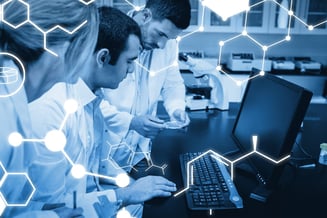
Together, Bioinformatics and Biostatistics are foundational sectors in the Life Sciences industry, driving a positive impact for public health research and decision-making. While the fields sound similar and the roles of Bioinformaticians and Biostatisticians both deal with data, there are unique functions for each. Together, they work hand-in-hand to improve people and animals' health worldwide, playing a critical role in transforming the lives of those with serious diseases, their families, and society.
The problem is, there’s a blurred line between the two. Figuring out the difference between the fields is one element. Still, another very real challenge presents itself to those hiring within clinical labs – how do you fill seemingly similar technical roles with the right talent? Even people who work as Bioinformaticians and Biostatisticians often flip between the titles in discussing their responsibilities since the ties are so close. With that in mind, here’s where the actual distinction lies between Bioinformatics and Biostatistics.
Bioinformatics
Bioinformatics is defined as “the science of collecting and analyzing complex biological data such as genetic codes.” In the Life Sciences industry, Bioinformatics serves as the sector that’s developing and applying computational algorithms and analysis methodologies to big biological data such as genetic sequences and patterns.
In their role, a Bioinformatician does a lot of applied work and must be knowledgeable in the fields of biology, computer science, and statistics. They’re critical thinkers and problem-solvers with a strong scientific understanding and experience in bioinformatics. In the lab, they’re responsible for data processing, visualization, integration, and mining. Most have a Master’s Degree and some experience in a related scientific discipline, such as Computer Science, Genomics, Biostatistics, or Bioinformatics.
Because of the high level of technical expertise required of Bioinformaticians, some organizations turn to a third-party agency geared with the knowledge and resources to ensure their lab is supplied with top-notch talent.
Biostatistics
Biostatistics is defined as “the branch of statistics that deals with data relating to living organisms.” In the industry, Biostatistics serves as the Life Science of designing, conducting, analyzing, and interpreting studies aimed at improving public health and medicine. Anytime statistics such as “75% of people who smoke develop lung cancer" are heard, one can be sure that the hard work of a Biostatistician was behind it.
Here, the focus is primarily on human health. However, Biostatisticians may not work solely with human data. They analyze and study the determining factors that impact people, plants, and animals' health and well-being to arrive at conclusions about disorders, disease, or other health risks. With this information, a Biostatistician can study the effects of various treatments based on the findings and numbers of the analysis. They use computational tools to gather and analyze data in fields such as population, biology, genetics, and pharmaceutical development to solve for public health issues.
Compared to Bioinformaticians, Biostatisticians are heavily involved in statistics theory, with a strong foundation in statistical methodologies, programming, and mathematical problem-solving. Most have a Ph.D. or equivalent degree in Biostatistics, Statistics, or related quantitative field, as well as 2-5+ years of experience. As with Bioinformaticians, the high level of technical expertise required of Biostatisticians moves some organizations turn to a third-party agency to staff their lab with the right talent.
Want more info? Check out our free resume examples for a top-notch Bioinformatician and Biostatistician! ![]()
The Big Difference
Even with a better understanding of what each role does in its own right, you may still be thinking –what’s the difference? Put simply, Bioinformatics is more closely related to the biological data and tracking the trending, specifically of genomics data. On the other hand, Biostatistics works more closely with broad, big-picture data to solve public health issues.
Despite their differences, the combined efforts of Bioinformaticians and Biostatisticians are critical in most clinical settings. Now, the big question I have for you is, who do you need in your lab?




